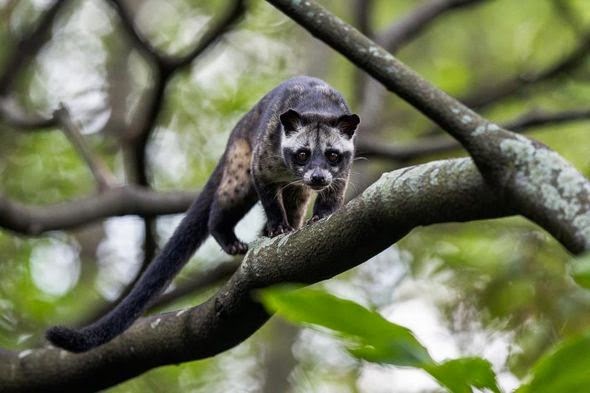[Most Recent Entries] [Calendar View]
Tuesday, November 18th, 2014
| Time | Event | ||||||
| 1:03a | [Ichthyology • 2014] Limatulichthys nasarcus • A New Species of Limatulichthys Isbrücker & Nijssen (Loricariidae, Loricariinae) from the western Guiana Shield
Abstract Limatulichthys nasarcus n. sp. is described as a new species based on 15 specimens from the Ventuari and Caura Rivers in Southern Venezuela. The new species can be distinguished from its only congener, L. griseus, by the presence of anterior abdominal plates half the size of those at center of abdomen (vs. plates similar in size); distinct spots less than half of diameter of naris across entire dorsum, including snout and head (vs. indistinct dorsal spots larger or equal than diameter of naris); lateral portions of head and opercle with dark well-defined spots larger than those on dorsum (vs. spots on lateral portions of head and opercle equal in size to those on remainder of body); snout profile in dorsal view broadly rounded (vs. acutely triangular); head longer (21.4–24.2 SL vs. 17.7–21.0%); and anal fin longer (15.7–18.0 SL vs. 13.7–15.6%). Distinctiveness of the two species is further supported by their non-overlapping distribution in multivariate morphospace. The disjunct distribution of L. nasarcus across both the Caura and Ventuari rivers exclusive of the main Orinoco River channel contributes to a growing body of evidence supporting the historical connection between headwaters of these drainages. The hypothesized existence of a ‘proto-Berbice’ paleodrainage provides one explanation for such a connection. Keywords: Limatulichthys, Neotropics, taxonomy, Ventuari, Caura Londoño-Burbano, A., Lefebvre, S.L. & Lujan, N.K. 2014. A New Species of Limatulichthys Isbrücker & Nijssen (Loricariidae, Loricariinae) from the western Guiana Shield. Zootaxa. 3884(4): 360–370. | ||||||
| 4:46a | [Mammalogy • 2014] How Many Species of Paradoxurus Civets are there? New Insights from India and Sri Lanka
Abstract Using molecular data and morphological features, we investigated the species limits and genetic diversity among populations of the Asian palm civets of the genus Paradoxurus. Our main objectives were to determine the number of species within Paradoxurus hermaphroditus and to test the validity of the newly proposed species within Paradoxurus zeylonensis. Fragments of two mitochondrial (Cytochrome b, Control Region) and one nuclear (intron 7 of the beta fibrinogen) markers were sequenced from 128 individuals of P. hermaphroditus, P. zeylonensis and Paradoxurus jerdoni. DNA sequences were analysed using phylogenetic and haplotype network methods. Our analyses confirmed that P. hermaphroditus comprises three major clades, which should be recognized as separate species: Paradoxurus hermaphroditus (Indian and Indochinese regions), Paradoxurus musangus (mainland Southeast Asia, Sumatra, Java and other small Indonesian islands) and Paradoxurus philippinensis (Mentawai Islands, Borneo and the Philippines). Furthermore, we have proposed that there are two subspecies within both P. musangus and P. philippinensis, and there might be at least two or three subspecies within P. hermaphroditus. We found a very low genetic diversity and no geographical structure within P. zeylonensis and did not find any support for splitting P. zeylonensis into several species nor subspecies. Finally, we confirmed that P. jerdoni and P. zeylonensis are sister species. Keywords: Asia; taxonomy; palm civets; Paradoxurus; Viverridae; Molecular systematics
Géraldine Veron, Marie-Lilith Patou, Mária Tóth, Manori Goonatilake and Andrew P. Jennings. 2014. How Many Species of Paradoxurus Civets are there? New Insights from India and Sri Lanka. Journal of Zoological Systematics and Evolutionary Research. 1-14. doi: dx.doi.org/10.1111/jzs.12085. The common palm civet, Paradoxurus hermaphroditus, has been split into three species by a recent study (Veron et al., 2014). The name Paradoxurus hermaphroditus is restricted to the populations in India, southern China and Indo-china (henceforth as Indian palm civet). The form in Singapore, peninsular Malaysia, Sumatra and Java is Paradoxurus musangus (Sumatran palm civet), named by Sir Stamford Raffles in 1821 as Viverra musanga based on animals from Sumatra. Those in Borneo and the Philippines are Paradoxurus philippinensis (Philippine palm civet) Marcus A. H. Chua & Fung Tze Kwan. 2014. Sumatran palm civet at Grange Road. Singapore Biodiversity Records. 2014. http://lkcnhm.nus.edu.sg/nus/images/pdfs/s |
| << Previous Day |
2014/11/18 [Calendar] |
Next Day >> |




